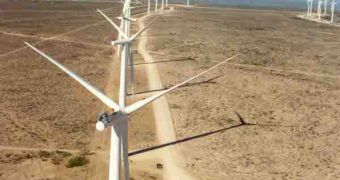Over the past few years, America has consolidated its role as a leader in the design, development and production of renewable energy, through its wind farms, solar plants and geothermal harvesters. The old economy, based on burning fossil fuels, such as oil, gases and coal, is being overrun by a new, cleaner one, which relies on wind, water, heat and the sun to produce electrical current. Some states even took action independently from the federal government, by adopting bills that bound them to reduce their carbon emissions in 10 to 20 years.
The state of Texas finally exceeded California in terms of wind-powered electrical plants, with its massive wind farms producing more than 6,000 megawatts of power annually. But that's not the end of it. Projects already approved by the state total up to an amazing 39,000 megawatts of generating capabilities. The projects are either in their early stages or already under construction.
Clipper Windpower and BP are two companies that are going to build another Titan wind farm in South Dakota, with an estimated electrical output of about 5,050 megawatts, which is several times larger than the biggest wind farm to be built in Africa and also exceeds the army's most ambitious renewable energy project to date. This plant alone will supply energy for roughly 4 million people, about 5 times the number of inhabitants this state currently has.
The states of Maine, Delaware, New York and Oregon also plan to build more wind farms, either on land or offshore, with totaled estimated outputs of about 10,000 megawatts, which is more than their populations will require in the foreseeable future. And that's not counting regular power plants that use coal, oil or gases. Oregon's Columbia River Gorge, which has a tremendous potential, will be used to generate some 900 megawatts of electricity for the region.
Solar energy currently accounts for a 420 megawatt contribution to the nation's power grid, but, in the near future, these numbers are likely to jump to about 3,500 megawatts, given the latest breakthroughs in harnessing solar energy, either through photovoltaic cells, or through solar thermal facilities located at about 10 strategic locations throughout the continental U.S.
All in all, with the rapid expanse of renewable energy sources in places that were previously thought to be fossil fuel "strongholds," such as the state of Texas, all that remains is for authorities to start developing an even more powerful national grid, capable of handling inputs from so many varied sources without a glitch. One could say that, indeed, the future is bright.

 14 DAY TRIAL //
14 DAY TRIAL //